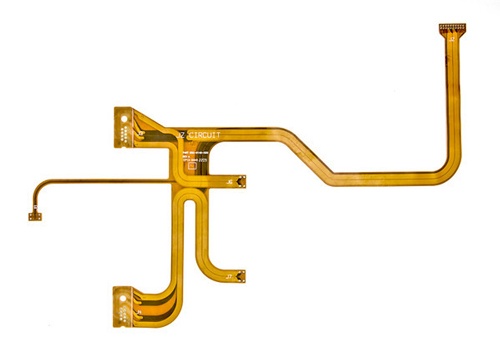Considering using a flexible printed circuit board (flex PCB) in your next project? Flex circuits offer several advantages, whether you plan to use them in a future project or for revamping your existing designs. Here we detail some of the most impactful advantages of flex PCB, including packaging, reliability, capabilities, and cost savings.
Flexible Circuit Packaging Freedom
Unlike rigid printed circuit boards, flex circuit boards can be made to fit where other solutions aren't viable. You can save even more space by replacing a wired assembly with a flex circuit. Flex PCB designs typically require only around 10% of the space and weight as taken up with wired solutions. Flex also offers an increase in tighter bend capabilities. Because of its ability to more efficiently occupy space, there may even be opportunities to replace multiple circuit boards, connectors, etc. with a single rigid-flex unit.

Flexible Circuit Board with Multiple Interconnects

Reliability of Flexible Printed Circuits
When it comes to reliability, flex and rigid-flex PCB's have you covered. Flex can reduce the overall number of interconnects required, which in turn means fewer solder joints, connectors, and contact crimps. With fewer interconnects there will be fewer potential sources of failure resulting in improved reliability. Additionally, the weight reduction and flexibility of the circuit improves vibration and shock performance.
Flex PCB Capabilities
Flex material properties perform very well in high-speed controlled impedance designs. As far as component/connector assembly is concerned, flex circuits accept any component or connector that can be assembled to a rigid PCB. Additional options available include ZIF connectors, crimped contacts, and direct solder.
Flexible circuits also perform well in harsh environments. Extreme temperature applications can run up to 200°+ Celsius and flex provides better heat dissipation than rigid printed circuit boards. Flexible circuit boards also have excellent resistance to chemical, radiation, and UV exposure.
Cost Savings Benefits
Performance benefits aside, factoring the savings benefits alone make flexible circuit boards worth the investment. Using flexible PCB reduces the overall finished assembly packaging and material requirements, creating lower cost shipments. Replacing multiple components lowers assembly costs due to fewer parts and simplified installation. Increased reliability of flex PCBs creates longer-lasting products, again saving you from having to spend more on reorders.
Summary
Now that you know some of the most crucial flex PCB advantages you're ready to start seeing improved packaging, reliability, capabilities, and cost savings with your products. Epec is here to help bring your design to life! Get your quote now or check out our free design guide below.
Key Takeaways
- Space and weight savings: Flex PCBs can reduce packaging size and weight by up to 90% compared to wired solutions, offering tighter bend capabilities and even the potential to consolidate multiple boards into a single rigid-flex unit.
- Improved reliability: By reducing the number of interconnects, solder joints, and connectors, flex circuits minimize failure points and enhance performance under vibration and shock.
- Broad design capabilities: Flex PCBs support high-speed controlled impedance designs, accept standard PCB components, and allow for options like ZIF connectors, crimped contacts, and direct soldering.
- Durability in harsh conditions: Flex materials withstand extreme temperatures above 200°C, offer better heat dissipation, and resist chemicals, radiation, and UV exposure.
- Cost-saving potential: Flexible PCBs lower material and assembly costs, reduce shipping expenses, and extend product life cycles, leading to long-term savings.
















